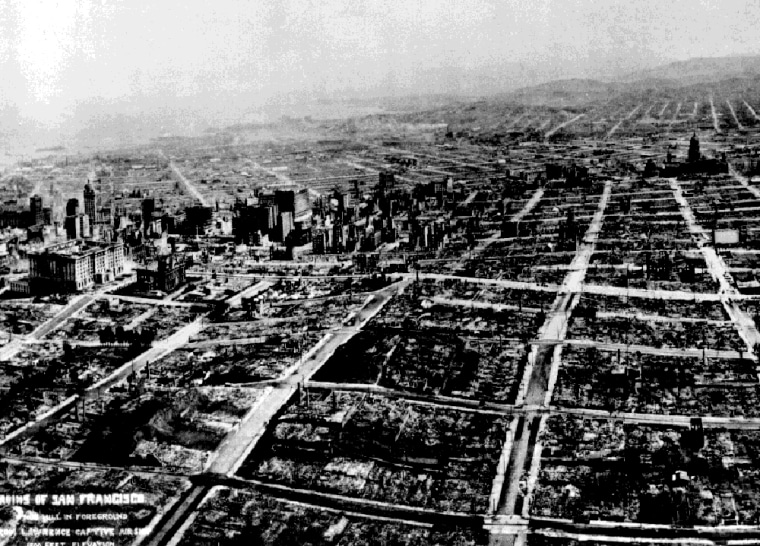SAN FRANCISCO — Being assigned to shoot TV segments for the centenary of one of the greatest U.S. disasters, the Great Quake and Fire of 1906, was a reminder that the event was one of the first major stories to be covered by both moving and still photography.
Perhaps more notable, it also saw the birth of the citizen photojournalist.
After the ground stopped shaking and people took account of themselves and their families that April morning, they did what many people would do today. They journeyed out into the streets of San Francisco and began taking photographs.
The "Brownie"
And like many innovations, it was made possible by a technical advance, in this case the Kodak Brownie camera.
"There were thousands of people who owned the little Kodaks — with the drop-in roll of film — and they grabbed their cameras and ran into the streets,” said James Dalessandro, a San Francisco filmmaker.
“So there are literally tens of thousands of photographs taken by amateurs," Dalessandro said, "and some of the most striking images were actually taken by amateurs."
The Brownie cameras were first introduced in 1900. "It was the great Christmas and birthday gift, so there were thousands in San Francisco,” said Dalessandro. “It was the first major disaster that was ever photographed at that level."
But not all of the disaster was covered with the same intensity. Although several hundred thousand photographs were taken, the shooting all but stopped after a few days.
"You'll notice if you look at the thousands of photographs," Dalessandro said, "that there's a lot of the earthquake damage, and of the early fires and of people streaming down Market Street, and the [first two days of the] fire. There is very little of the last day, when the flames are incredibly high, and when the Navy was evacuating people, because they simply ran out of film. They also were fleeing for their lives."
Not all amateurs
Not all of the photographers were nameless amateurs. Famed writer Jack London ("The Call of the Wild," "White Fang"), also a talented lensman, was one.
On the morning of the quake, London and his wife, Charmian, were woken by the ground shaking at their home in Sonoma, about 50 miles north of the city. In the early dawn light they could see San Francisco burning. They grabbed their cameras, the made their way to the city by horse and train, and by nightfall were wandering through San Francisco taking pictures and interviewing survivors. Many of the photographs they took were published in the magazines of the time.
A time for innovation
Some of the most inventive photographs grew out of attempts to get the "big picture” of the entire city that would sum up the disaster for people across the world.
Harry J. Coleman of the San Francisco Examiner tried aerial photography from the basket of a balloon, but his craft only carried him a short way before sinking back to the ground.
Success was finally achieved when George Lawrence of Chicago flew a custom-made camera on the end of a string of seventeen kites with a wire strung to trip the shutter with electrical current. This device took dramatic panoramic photos of the city from between 650 to 2,000 feet. These photos are reported to have sold for $125.00 each, a small fortune at the time.
Although some of the buildings photographed in 1906 have since disappeared, several skeletons of still existing buildings can be seen in the photographs of the ruins left by the quake and fire.
The Palace Hotel, The St. Francis Hotel, The Call Building and the Ferry Building are major landmarks today that can be matched fairly easily with the 1906 shots.
‘Citizen photojournalists’
Looking back at the treasure trove of material, I wonder if these “citizen photojournalists” had any idea of the contribution they were making to history. What if those Kodak cameras had been on the Titanic or in the Galveston Hurricane of 1900?
The citizen photojournalist has come a long way since the Great Quake. Now we see cameras everywhere.
The citizen photojournalist was in the Indian Ocean recording the 2004 tsunami and in New Orleans capturing images of Hurricane Katrina and her aftermath.
Still waiting for ‘The Big One’
Meanwhile, as a news photographer, it is my obligation to be ready to shoot most, if not all, of the time.
For instance, I covered the 6.9 Loma Prieta Quake which rocked the Bay Area in 1989. As we rushed out to take pictures at the time, we thought it was "The Big One" we professionals were waiting for, the once-in-a-lifetime event for the history books.
But we soon knew it paled in comparison to 1906, and once again I am waiting.
